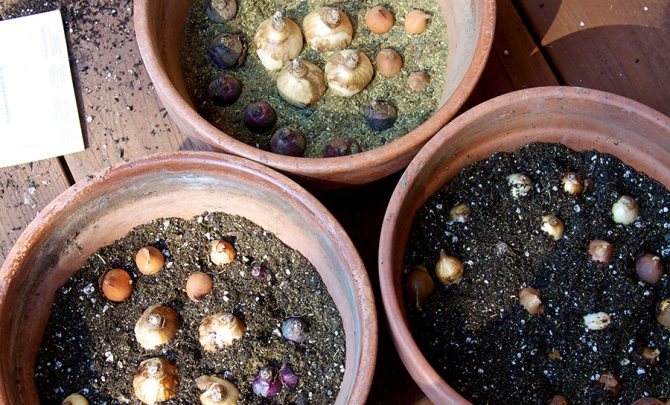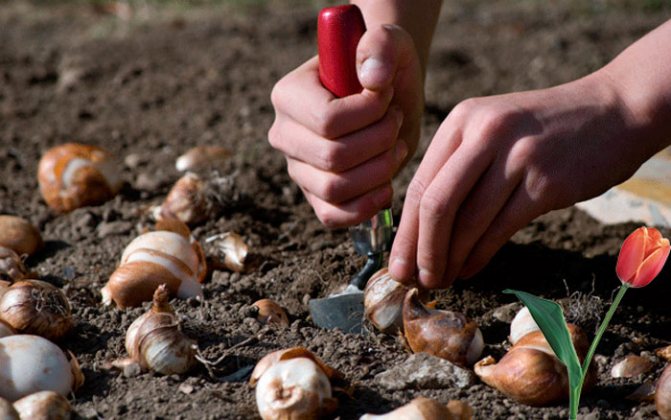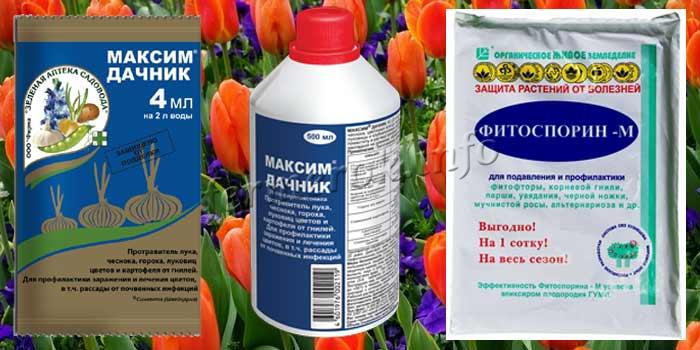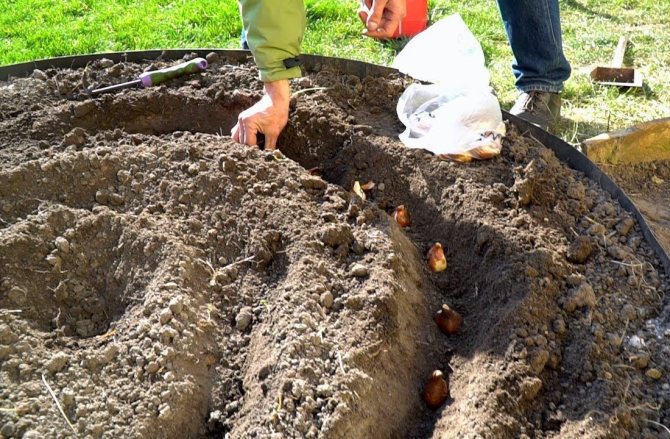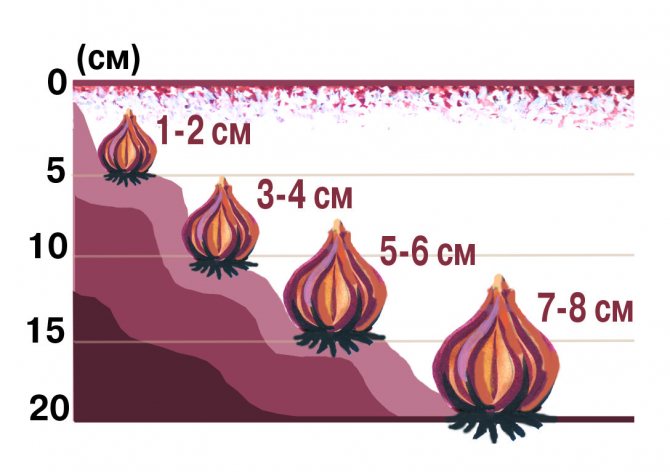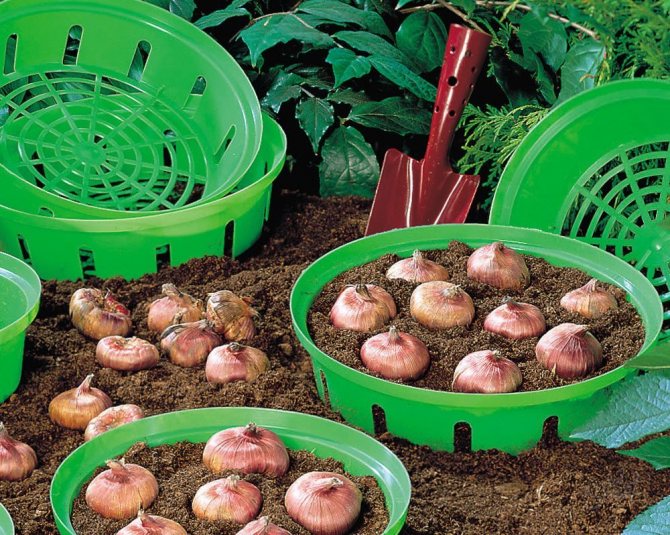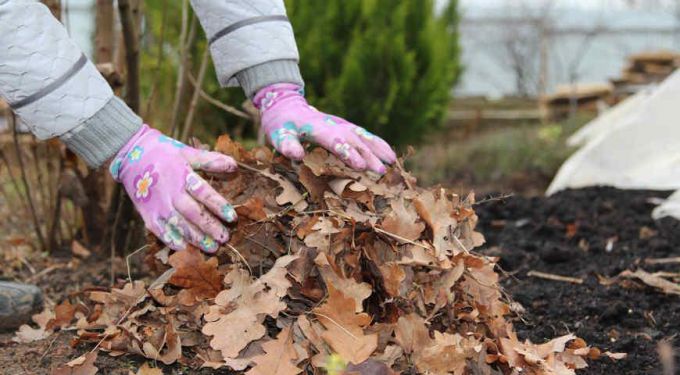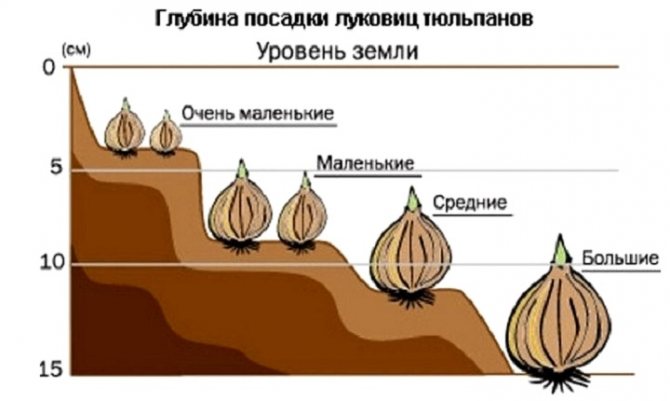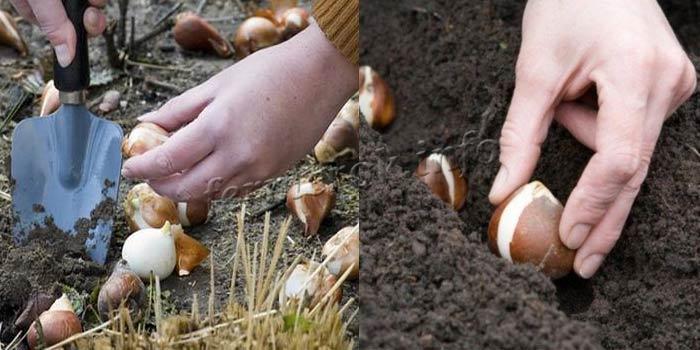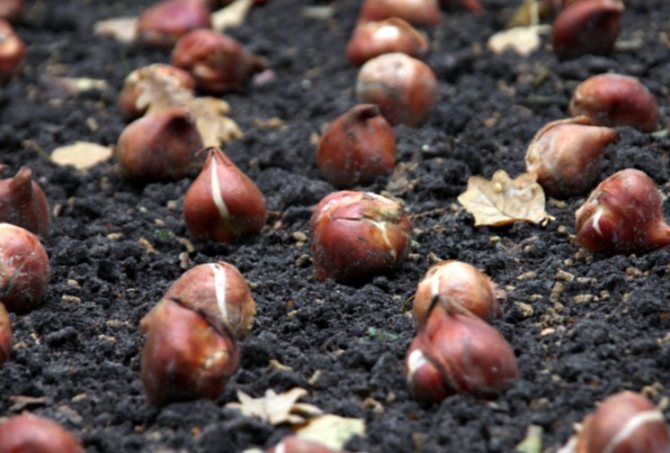Tulips amaze with their flowering in early spring. Their luxurious flowering largely depends on adherence to the timing of planting, digging after flowering, preparation for the dormant period. Knowing the features of the life cycle of a flower bulb, you can choose the right time to plant tulips in the fall in the suburbs in order to get a luxurious blooming carpet from the first warm days.
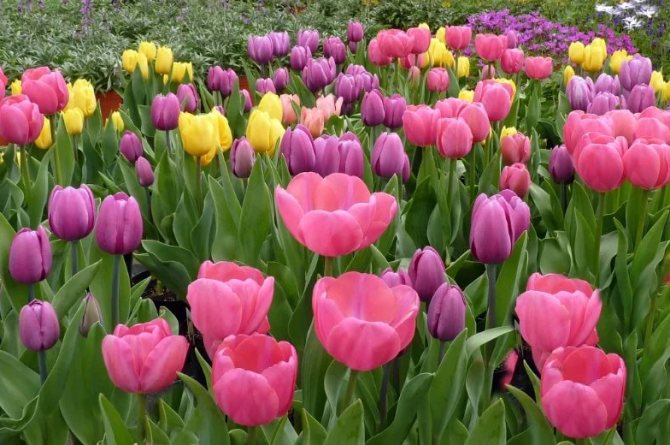
When is it better to plant tulips: autumn or spring
Bulbous crops planted in the spring do not have much difference in care from the tulips of autumn planting.
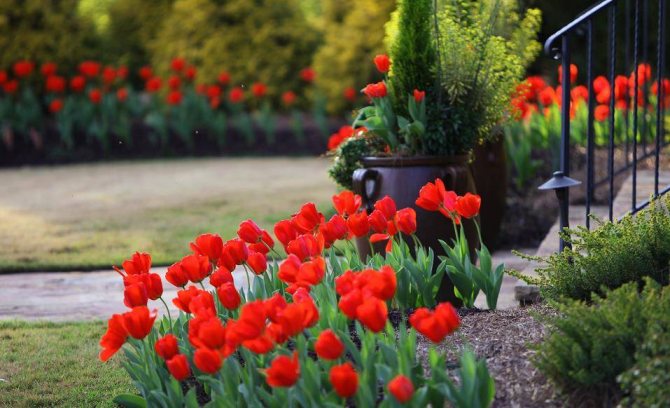

The choice of the season depends on the climatic conditions, among other things, the autumn and spring plantings have their advantages and disadvantages, which must be taken into account.
Pros and cons of each season
| Period | Dignity | disadvantages |
| Spring | You can carry out a complex planting of ornamental crops immediately after the design of flower beds. There is no need to store planting material in winter. The risk of death of bulbs from frost is minimal | Tulips planted in early spring come into bloom later or do not form flower stalks at all. It is required to harden the bulbs and their mandatory processing before planting |
| Fall | During the autumn period, the planting material most often builds up a powerful root system, is saturated with nutrients from the soil and safely survives the winter. Natural hardening of the bulbs takes place. Spring flowering is abundant and long lasting. In the autumn, the choice of planting material is very rich. | Burrowing into the ground requires strict adherence to deadlines depending on weather conditions. There is a risk that the rooting process will not have time to go through before the onset of frost and the bulbs will freeze. Planting material can be damaged by various pests wintering in the soil, pathogens, as well as rodents. |
Preparing for winter


Preparing tulips for winter is about protecting them from the cold and rodents.
From rodents, the planted plants are protected by a shelter made of spruce branches. Spruce branches additionally protect plants in severe frosts.
Before the onset of stable cold weather, tulips are covered with a 5 cm layer of straw, peat, pine needles, spruce branches or dry leaves of trees. These measures protect flowers from freezing and increase the number of buds in the next season.
Falling snow is a natural protection from the cold. With a small thickness of the snow cover, the bulbs are protected from the effects of negative temperatures. The snow cover also prevents soil cracking, which can damage tulip roots. The rate of thawing of the earth with the arrival of spring in the presence of snow on the flower bed accelerates. Moreover, when it melts, the snow saturates the plants with moisture.
With the onset of spring, the shelter is removed from the plants, which allows the plants to grow and develop faster.
General landing dates: table
The assortment of bulbous plants is rich, for each species there are optimal planting dates, which vary depending on the season and the region of cultivation.
| Rregion | Fall |
| Moscow and Moscow region | From the third decade of September to October 15 |
| Leningrad region | From the third decade of September to mid-October |
| Middle lane | September 20-30 |
| Ural | In the north - until September 10–20, in the southern part - until October 10 |
| Siberia | from late summer to September 15 |
| South | From mid-September to the second decade of October |
| Belarus | From late September or early October |
Rooting of tulip bulbs takes about a month and a half, so it is very important to strictly adhere to the timing of the autumn planting. An ornamental culture, even before the onset of frost, must grow a good root lobe that feeds the plant throughout the winter period. When planting too early, the growth processes of the flower are activated, and late planting does not allow the roots to fully develop. If the recommended planting dates are violated, delayed flowering, winter freezing or death of the plant are observed.
About the rules for the autumn planting of other bulbous flowers, you can learn more from the material:
Planting care


After planting tulips, no need to water the bulbs. If there has been no rain for 10 days, the flower bed is moistened from the watering can.
When watering plants, you can feed them a little with ammonium nitrate (15 grams per square meter of flower bed).
In warm weather, it is not necessary to cover the planted tulips with mulch, since excess heat will provoke premature growth of the bulbs and the sprouts will die in case of frost.
How and where to store bulbs until autumn planting
In the process of storing tulip bulbs until autumn planting, certain requirements must be met:
- at the initial stage of storage, the temperature regime should be approximately 23–25 ° C;
- by the onset of August, the temperature in the storage should be lowered to 20 ° C;
- about a week before planting on open ground flower beds, the temperature drops to 15 ° C;
- excessive moisture in the storage should be prevented, as otherwise the risk of bacterial and fungal diseases increases;
- it is important to monitor the humidity of the air in the storage, otherwise the bulbs may dry out or die;
- the room should be well ventilated.
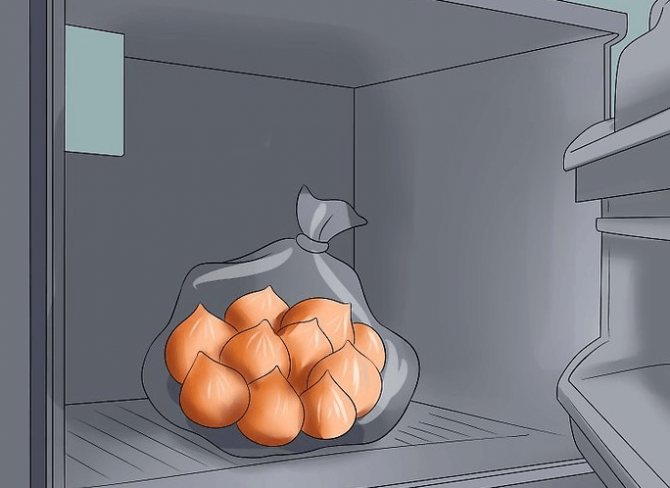

If necessary, the lower shelf of a conventional refrigerator can be used for storage.
Experienced growers advise wrapping the flower bulbs with newsprint, which will prevent the development of diseases, decay or excessive drying.
Digging and storing the bulbs
It is advisable to choose tulip bulbs from the soil annually. For these flowers, it is important at what depth they grow, and as you know, over time, bulbous plants deepen. The total number of bulbs during the growing season increases due to the appearance of "babies". Their nutrition is deteriorating, which affects the productivity and quality of flowering. Digging is also a preventive measure that prevents the development of diseases.


It is very important to collect the bulbs on time. If you dig them out ahead of time, then the protective scales will not have time to fully form. This will create difficulties in storing planting material. In this state, it is easy to damage it and it is not easy to protect it from fungal infection. The decorative varietal features of the flower may also be lost.
Digging, like planting, depends on the place of growth and the type of plant. Usually these works can be performed from the end of June to the beginning of August. You should focus on the state of the aboveground parts of the plant. The bulbs ripen by the hour when the leaves turn yellow and begin to dry out, and the stem becomes soft and can be rolled freely into a ring. If sick specimens are found, it is recommended to burn them completely, along with the foliage and underground part. Quality material is grouped according to the variety and the size of the bulbs.
Why is the houseplant female happiness so called
The bulb heads should be tight, with a dense, stain-free protective layer. Rotten, sick and damaged samples are discarded. If the damage is minimal, then they can be sprinkled with coal powder or treated with a manganese solution.Insufficiently large bulbs are also planted. But one should take into account the high probability that they will not give flowers in the first year. So for them, you can select a separate, not particularly noticeable area. The smallest bulbs may take two years before they can start flowering.
The collected bulbs are dried in shade, provided there is good ventilation, for 1-2 days. After that, the stems are cut and the onions are removed for storage. Particular attention is paid to the room temperature. At first, it should be maintained at + 25 ° C, and then gradually reduced. So, in August it should be + 20 ° C, in September + 17 ° C, and a week before landing, it should decrease to + 13 ° C.
Undoubtedly, every experienced grower has his own ideas about the correct preservation of bulbous material. Experts advise to adhere to these rules:
- Digging is best done with a pitchfork. This minimizes the chance of damage to the bulbs.
- It is recommended to store them in wooden boxes or wicker baskets, which should be placed on a dry surface.
- The store must be ventilated. However, drafts, like dampness, are unacceptable.
- Pour the bulbs in a small layer. To prevent waterlogging, you can use sawdust or crushed chalk.
- The material should be periodically inspected and rotted and moldy specimens should be removed in time.
- Keep in mind that the bulbs can be damaged by rodents.
How to process the bulbs before planting
Pre-planting treatment is a very important stage that improves the survival rate and is the prevention of diseases and pests of ornamental crops. For this purpose, industrial preparations or time-tested folk remedies can be used.
The main methods of preparation:
- Peeling the bulbs from the husk.
- Visual analysis of planting material for damage and lesions by pathogenic microflora.
- Sort the bulbs according to size.
- Disinfection procedure.
Hard integumentary scales are removed from the planting material, under which hidden foci of infection are most often located.
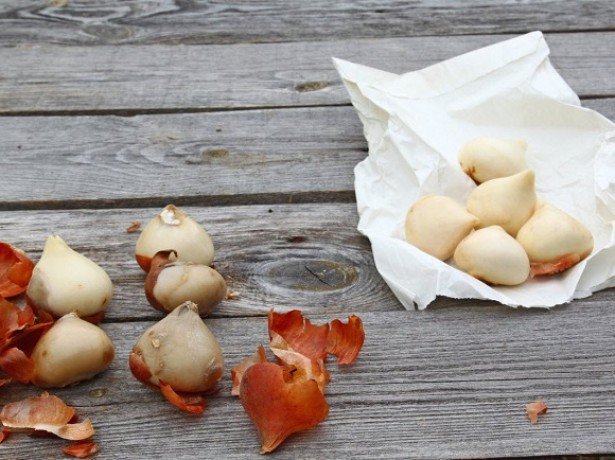

Bulbs peeled from the husk are better absorbed from the soil
After cleaning and careful inspection, the bulbs are sorted by diameter.


Traditionally, for the processing of planting material, a weak pink solution of potassium permanganate or a modern antifungal drug Fundazol is used, 15 g of which is dissolved in 5 liters of water
There is a wide range of state-of-the-art treatments on sale that protect the bulbs and stimulate their growth processes.
| A drug | Breeding | Processing method |
| Vitaros | 2 ml / l of water | Spraying before planting |
| Epin | 0.5 ml / l of water | Soaking the bulbs for a day |
| Maxim | 2 ml / l of water | Soaking the bulbs for half an hour |
| Fitosporin | 20 g / l of water | Spraying before planting |
How to get the right fit
Tulips are planted in the prepared soil in the fall; the bulbs themselves also require appropriate processing. It is convenient to land using special lattice baskets for bulbous or low plastic boxes for vegetables, the height of the sides of which does not exceed 7-10 cm. the method has several advantages:
- the time for digging in the summer is reduced;
- the possibility of damage to the bulbs during harvesting is reduced to zero, since not the plants themselves are dug out, but the containers in which they are placed;
- there are no forgotten onions in the ground;
- tulips can not be selected annually, since the bottom of the containers used does not allow them to go deep into the ground;
- if the flowers are not planted in a row, then with the help of planting baskets it is convenient to form various compositions on the flower bed.
The most popular climbing flowers for garden decoration
With the traditional method of planting tulips, you can use another device - a metal cone with centimeter markings. Since the bulbs, depending on the caliber, are immersed in the ground to a certain depth, it helps to accurately measure it and avoid errors. But you can do without all this successfully.
Working with planting material
A few days before planting, the temperature regime for storing the bulbs should be lowered to thirteen degrees. Sometimes cooling is carried out in the refrigerator. This facilitates rapid adaptation of the bulbs and initiation of root growth. They are kept here throughout the day in the vegetable compartment. The planting material should be reviewed again, taking only healthy samples.
Immediately before planting, all the bulbs are soaked in a solution of a fungicidal agent (Fundazol, Fitosporin, Maxim) or potassium permanganate for half an hour. This will help prevent fungal infections. After the bulbs must be dried and planted immediately, as being moist, they are more likely to take root.
Site selection and soil preparation
It is recommended to change the place of planting of bulbous flowers every few years. Tulips like bright open areas. Under the condition of shading, their stems lengthen, bend, become more fragile, and the size of the bulbs, on which flower production directly depends, is significantly reduced.
The soil should be fertilized in a timely manner. In addition, the plants themselves are fed several times: after pecking, before flowering and after it ends. Fertilizers need to be selected depending on the characteristics of the soil. If the land is fertile, then the use of mineral complexes will be enough. In case of depletion of the soil, it is also necessary to introduce organic matter in the form of peat or humus.
Light soil is best for tulips. If it is too dense, then add sand and compost prepared in advance. Also, before planting, it is flavored with potassium and phosphate additives, which will ensure good vegetation and abundant flowering. A coarse-grained sandy substrate with the addition of small pebbles is suitable for drainage. It is poured into the bottom of the holes, and a layer of humus-enriched soil is placed on top.
The flowerbed must be dug up. It is better to do this two weeks before planting. The recommended digging depth is 35 cm. Compost, superphosphate and potassium salt are added at this stage.
Tulip planting rules
The planting material is placed in holes or grooves. The planting depth depends on the size of the bulbs and should be three times their height. If you plant them deeper, then they may not rise on time in the spring. Shallow planting leads to a decrease in the size of flowers, the formation of small bulbs and weak "babies" or can cause the plant to freeze in winter. Thus, given that the largest specimens reach 5 cm, holes for them are dug 15 cm deep, and the smallest of them are inserted into the ground only 6-7 cm.
Ampel pelargonium: reproduction and care at home
In accordance with agrotechnical requirements, plants are planted at a distance of at least 10 cm from each other. In this case, the interval between the beds should be about 25 cm. But with the compositional design of the flower bed, a more heaped arrangement of tulips looks much better. Therefore, subject to the annual digging of the bulbs, they can be safely planted at a distance of only 6 cm.
When the soil is not sufficiently moistened, then it will be necessary to moisten it well. The bulbs are placed with their bottom down without much pressure, otherwise the root buds may be damaged. A little wood ash, humus or compost is poured into each hole, if this was not done while digging up the flower garden. Fresh manure cannot be added, otherwise the onions can pick up the fungus. The ground must be carefully leveled. In the existing irregularities, water can stagnate, which will lead to decay of the roots and loss of tulips.
Is it worth fertilizing the land
For the cultivation of tulips, flower beds are distinguished with light, sandy loam, and humus-rich soils. Sandy and heavy soil is unsuitable for such a flower culture. River coarse sand is necessarily introduced into the clay soil, and too light sandy soil can be improved with the help of humus, peat or sod soil.
The material on how to care for the soil in the country will also be useful:
Recent Entries
Rose Petal Jam and Its 7 Health Benefits You Likely Didn't Know About What Fruit Are You According to the Zodiac Sign 11 Best Grape Varieties That Will Help You Create Unique Homemade Wine
The ornamental plant feels best in well-lit, without stagnant water and well protected from gusts of cold wind flower beds, but late-flowering varieties can be placed in partial shade. Too much shading will cause the bulbs to shred.
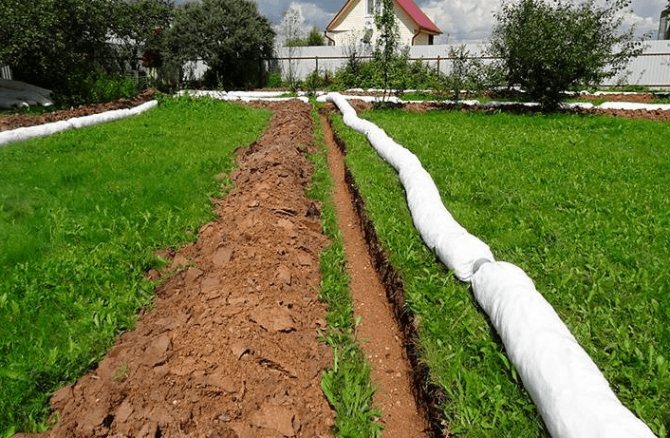

To combat the high occurrence of groundwater, drainage grooves are installed at a depth of half a meter.
Excessive organic matter can adversely affect the flowering process. In this case, the flowers have an irregular shape, and all the forming peduncles differ in curvature. When applying fresh manure in any amount, rotting of the plant roots is often noted, so such daughter bulbs are unsuitable for reproduction.
Green manure plants plowed into the ground, as well as previously disinfected compost, have a good effect on the growth and development of tulips. It is very important that the soil of the flower garden has a neutral or alkaline reaction; for this, measures are taken to liming the soil. However, in a number of countries, fertilization for tulip cultivation is considered extremely harmful. In addition to organic matter, the introduction of mineral fertilizers is of no small importance, which positively affects the flowering time and the size of the bulbs.
How to carry out liming of the soil in the garden, you can learn from the material:
Temperature and optimal timing
Tulips are quite unpretentious plants, but if you do not follow the rules for collecting, storing and planting bulbs, you can get an unpleasant result. Planting dates are just as important. When deviating from them novice gardeners often face various problems:
- loss of planting material;
- rotting or freezing of planted bulbs;
- plants do not sprout in spring or hatch late;
- flowering arrows do not appear;
- "blind" buds are formed, which fail to open;
- flowering is late;
- flowers are small or disproportionate, with short, curved or thinned legs.
Timely planting "for the winter" allows the plant to properly settle in certain conditions, rest, preserving all the nutrients accumulated during the growing season, germinate and bloom early, and also ensure the rapid growth of daughter bulbs.
If tulips are planted prematurely, they will hatch even before the onset of winter cold, which will lead to their freezing. In addition, the flower garden can have time to overgrow with aggressive weeds, which will "clog" the tulips and prevent them from developing normally.
Late planting in the ground will not allow the bulbs to root properly. As a result, they will not sprout on time, which will cause flowering disturbances. Most likely, tulips will still bloom, but much later. But the new bulbs may not have time to grow, they will be small and unsuitable for high-quality flower production next year.
Plants need a month and a half to form the root system. The process must be completed before the onset of cold weather. The period when you need to plant tulips in the fall is determined by indicators such as temperature and soil moisture.These conditions depend on the specific region and the characteristics of local weather conditions.
Flower care male happiness at home
Many gardeners prefer to focus on the Indian summer, at the end of which they start planting bulbous peduncles. In many regions, this work falls on October - early November. In cooler climates, the bulbs are planted earlier - in the last decade of September or in the first days of October. In warm weather, late planting of tulips in autumn can be done at the end of November, and sometimes even at the beginning of December. In this case, it is imperative to cover the flowerbed with fallen leaves or other insulating layer, which will subsequently be covered with snow.
The soil must be sufficiently moistened. Its optimum temperature for planting bulbs is + 8 ° C on average. Slight fluctuations in both directions by 1-2 degrees are allowed. The soil temperature is measured at a depth of 15 cm. The time of planting flowers also depends on the characteristics of the variety. Early tulips are planted a couple of weeks earlier than later varieties.
How to plant tulips outdoors
Immediately after the etching procedure, the planting material is planted on pre-prepared flower beds. Lost planting time threatens to swell the bulbs and reduce germination. For planting, it is necessary to make special grooves, the depth of which is about 10-15 cm.


The standard planting spacing between bulbs is about 9-10 cm, but on heavy soils, planting is carried out at a shallow depth
On light soil, the bulbs are planted deeper. Among other things, varietal characteristics affect the planting depth:
- the bulbs of the extra-class varieties are deepened by 15–18 cm;
- planting material II-III parsing are planted to a depth of 10–12 cm;
- children are planted with a slight deepening.
On dry soil, furrows must be spilled abundantly with settled warm water. Fertilizer is applied to the bottom, if such an event was not carried out during the digging process. It is lightly sprinkled with sand, after which the bulbs are planted with the bottom down. To minimize the risk of root debris, the planting material should not be strongly pressed into the soil, and the bulbs are lightly powdered with ordinary wood ash before backfilling. Tulips are planted on the old flower garden after about 3-4 years.
Useful tips for florists
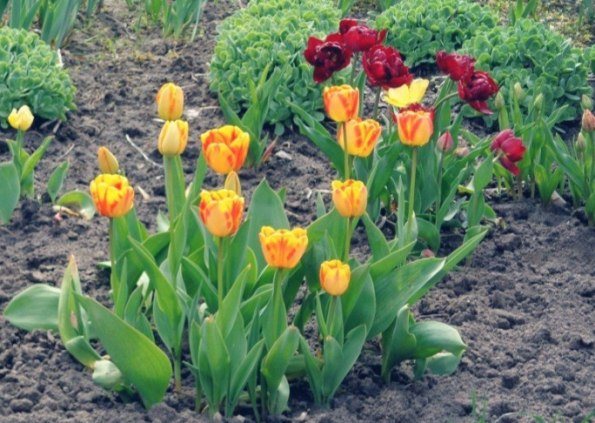

The annual transplantation of bulbs from an old flower bed makes it possible to form flower beds of the desired shape and density. If the bulbs are not dug up from year to year, they become smaller over time and may even disappear.
- Varietal tulips, annually harvested from the ground for further planting in the fall. Unpretentious and simple varieties are dug out 1 time in 2-3 years.
- Tulips return to their original place of growth no earlier than after 4 years, otherwise they will start to hurt.
- The soil temperature during planting, at a depth of 15 centimeters, should be kept at 7-10 degrees Celsius.
- Tulips can be planted even at the end of November - December, if there is snow. At the same time, the flower bed is covered with snow, dry leaves, spruce branches to prevent freezing of the bulbs.
- Tulips are best planted by variety. This makes it easier to care for them in the spring.
- The bulbs must be planted at least 2 weeks before the onset of frost, otherwise they will not have time to take root.
- Tulips with large non-standard flowers are quite whimsical to care for. They need a sufficient amount of micro and macro elements. These plants are fed more often than standard varieties.
- Plants also need a lot of nutrients in dense carpet planting. During the growing season, plants need to be fed 3-4 times.
- Manure for feeding is not used, as it leads to rotting of the bulbs. Chlorine-containing fertilizers are not used.
How to plant in boxes and containers
Growing tulips in boxes and containers is very popular in many countries, including Russia.
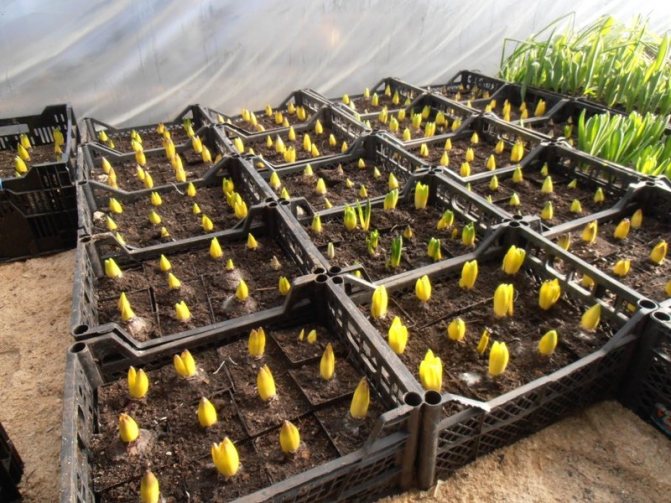

The container must be roomy, which will allow you to plant a large number of bulbs.
To fill a container or box, preference should be given to ready-made potting mixes that are guaranteed to be disinfected and free of plant parasites. If necessary, the nutrient substrate is prepared independently by mixing garden soil, vermiculite, high-quality humus, pure sand of the middle fraction and perlite with the addition of coconut fiber. The structure of the finished mixture must be sufficiently loose.
The marking of the site for the placement of containers is carried out in the autumn period, approximately in September. Containers or boxes are placed in the dug planting holes, the bottom of which is covered with sand, after which tulip bulbs are planted. The scheme of their placement varies within 4-15 cm and directly depends on the size of the planting material and the variety of ornamental culture. All bulbs are sprinkled with a nutritious soil substrate, after which the planting is mulched with a two-centimeter layer of humus or peat.
If you didn't manage to plant tulips in autumn - what to do?
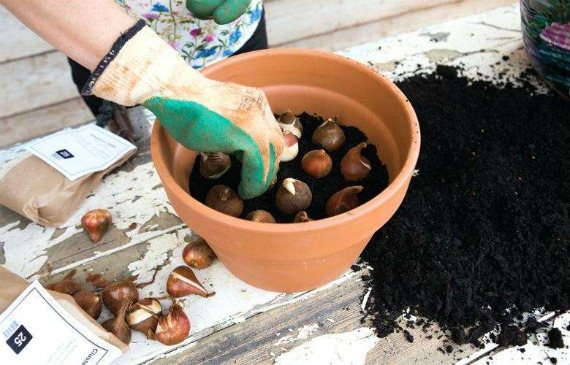

Sometimes it may happen that you got the bulbs after the autumn planting dates were over. Do not store them at home in order to plant them in the spring. Chances are good that the onions will go bad. You can save the planting material in a flower pot.
The container should be wide, with low sides and drainage holes. The bottom of the pot is lined with a thin cloth, any loose soil is poured to a height of 5 cm, then tulip bulbs are laid close to each other. They must first be etched in the same way as we do before planting in a flower bed, soaked in a solution of potassium permanganate or fungicide.
From above, the onions are covered with a layer of earth 7 cm thick and watered. For 3 weeks, the container is stored at home at room temperature. After a specified time, the pots are wrapped in a plastic bag and several layers of covering material, and then taken out for storage on the balcony. Tulips will stay there until spring, with the arrival of warmth they are planted on the site.
If you wish, you can arrange for forcing flowers, for example, by March 8th. Those who do not have a balcony can take the bulbs in a pot to their dacha and also, after wrapping them up, dig in the snow. In the spring, when the soil thaws, the bulbs are very carefully removed from the pot, trying not to damage the regrown young roots, and planted in the garden.
Planting and care technology
In order for the plants to be healthy and enjoy abundant flowering, you need to follow the exact instructions for growing these flowers.
Important! Tulips react extremely poorly to stagnant melt water, so they should not be planted in lowlands and on flower beds with high borders, where there is no drainage of excess moisture.
First of all, you need to decide on the place where to plant tulips. They do well in the beds where vegetable and flower crops were their predecessors, with the exception of representatives of the Solanaceous and bulbous family. Due to the fact that the flowering of tulips is lush, but rather short, they often coexist in flower beds with perennials, whose growing season begins later than that of spring flowers.


Soil preparation
After the desired tulip site is selected, the soil should be prepared for planting the bulbs. These flowers prefer loose, fertile soil with good drainage and neutral acidity. Tulips grow poorly, rot and die on clay soils with stagnant moisture. In order to increase the fertility of the land, two weeks before planting the bulbs, top dressing is carried out. For this, organic fertilizer is applied to the soil.
We recommend that you find out how to plant tulips beautifully and in an original way.
The rate for 1 m³ of soil is:
- compost or rotted manure: 5 kg;
- low-lying peat: 3 kg;
- nitrophoska: 50 g.


If necessary, the composition of the earth can be - to make the clay soil looser, you need to add about 7 kg of coarse sand or perlite to it. Slaked lime, introduced in a proportion of 200 g per 1 m³, will help to reduce the acidity of the soil. The day before planting the bulbs in the ground, you need to dig up the area and loosen the soil without leaving large clods. Immediately before planting, the ground should be disinfected by watering with a weak solution of potassium permanganate.
Did you know? The buds of the largest tulip variety Temple of Beauty reach a height of 14 cm, while the plant itself grows up to 1 m in height.
Preparing the bulbs for planting
Not only the soil needs preparation, the planting material should also be processed. To do this, the bulbs are carefully examined for rotting and the development of diseases. Poor-quality planting material is best destroyed, but not too damaged can be saved by cutting off the diseased area and sprinkling it with ash. This is usually done to preserve the rare bulbs.


After that, the bulbs are cleaned of brown scales, leaving only the ones that are as close to the bulb as possible. These scales should not be removed, since they protect the tuber from the effects of external factors and pathogens. Immediately before planting, the bulbs are treated with a 2% solution of "Fundazol". The planting material is immersed in a liquid for 30–40 minutes, after which it is left to dry, after which it is planted in the ground.
The nuances of landscape design
Small bulbs will not produce large flowers. They can be shaded by taller peduncles. Therefore, it is better to give them a place to edge the flower beds on its southern side. Or, you can simply make the distance between the bulbs large. Then the tulip lawn will have a natural uncultivated look.
The landing pattern can be more complex. When passionate about landscape design, the color of the flowers and the timing of flowering are taken into account. You can make a beautiful pattern by sketching in advance a planting scheme for different varieties and supplementing it with other bulbous primroses. A creative approach will allow you to grow a flower bed that all neighbors will envy.
Now in floriculture, alternative plantings of tulips are gaining popularity, attracting attention precisely by their unconventional nature. Among them there are quite simple ones, which will also help save the gardener's time. To master them, you do not need to be a certified specialist.
Planting times in different regions
As already noted, the timing of planting the bulbs directly depends on the weather conditions - they require rooting time, which is impossible at low temperatures. But in this case, seedlings should not form. Therefore, you need to adhere to certain deadlines, when to plant tulips in autumn:
- in Ukraine, Kazakhstan and the Kuban, the planting period falls approximately at the end of October - beginning of November;
- in central Russia, including St. Petersburg, this time falls in the first two decades of October;
- in Siberia and the Urals, it is better to plant tulips in mid-September, covering them with coniferous spruce branches or other insulation.
If frosts come suddenly, then planting can be done in early spring. This does not change the temperature range and agrotechnical requirements.
Preparation of planting material
In order for the material to take root well before the onset of winter, it is necessary not only to choose suitable days according to the lunar calendar, but also to properly prepare the bulbs in 2019.
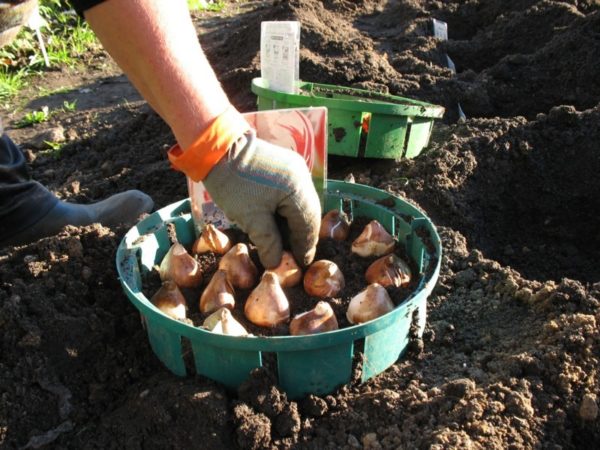

Before planting, they need to be sorted out, rejecting the spoiled and deformed, and then pickling in a solution of potassium permanganate of 0.5% concentration. This will protect them from:
- rot;
- mold;
- fungus;
- pests.
The planting material should lie in such a solution for 30 to 60 minutes, after which tulips can be planted in the fall on suitable days in open ground in Rostov and other regions of the Southern Federal District in the appropriate fall month of 2019.


Information!
Experienced gardeners choose autumn for planting, although tulips can be planted in spring. But only autumn planting allows to achieve abundant flowering.


You may be interested in:
When to plant tulips in the fall Planting tulips in open ground, as many flower growers know, should be started in autumn. Moreover, it depends on how timely ... Read more ...
Preparing the bulbs
Before planting, the tulip bulbs must be prepared. You need to do the following:
- Inspect each unit carefully. Here, the presence of decay, the beginnings of a disease, and various injuries are revealed. The main sign of a healthy and viable material is a tight and dry bottom. All bulbs that do not meet this parameter and have signs of disease must be discarded.


- Then the planting material is sorted by size. It is divided into large, medium and small.
- Excess husks are removed from all bulbs. This must be done more carefully so as not to damage the bottom. Getting rid of excess clothing will allow the future tulip to receive the full amount of nutrients.
- Each onion must be pickled from possible bacteria and fungi. Experienced gardeners use phytosporin for this, Maxim, a 0.1% solution of potassium permanganate. Planting material is kept in one of them for half an hour.
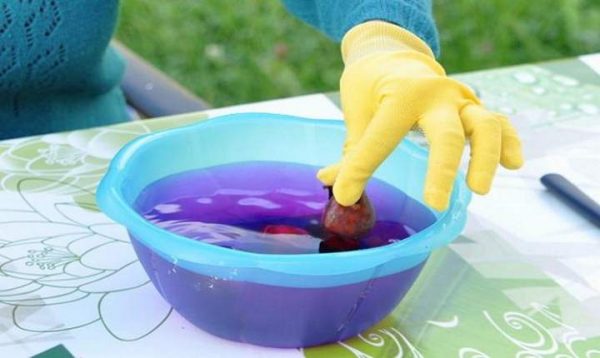

Site preparation


The quality of the sandy substrate is improved by the use of fragmented compost, which will provide plant nutrients and improve the moisture holding capacity of the soil. Heavy soil is weakened by the addition of degassed peat, quartz sand or perlite. In addition, it is worth adding a multicomponent mineral fertilizer with nitrogen content to the soil. Fertilizers are mixed with the soil after weeds have been removed. Treatments aimed at improving the structure of the soil are done 3 weeks before the planned planting date of tulips.
How to choose good tulip bulbs
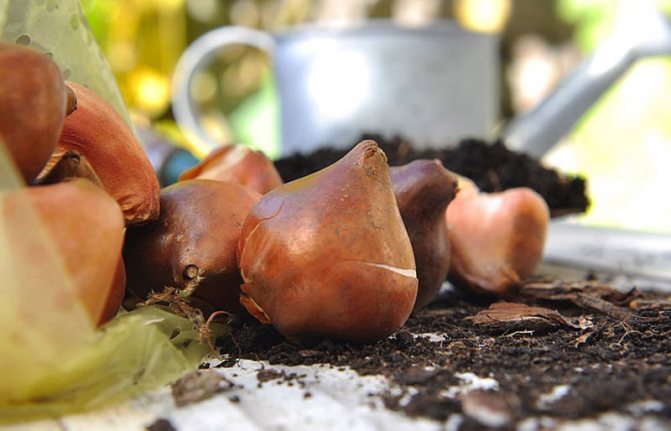

When buying planting material in a store, you need to choose only high-quality plants. It is important that they are not affected by diseases or pests. These bulbs may not sprout and infect nearby flowers. The root of the tulip should be firm to the touch. It is better not to purchase planting material in packaging, for which it is difficult to see the product. It is difficult to determine a healthy and high-quality bulb after seeing it. There should be no cracks or rot on the surface. You also need to discard the dried material, because he will not come up. The chance of rotting is always higher in cellophane packaging. If stored correctly, the bulb will grow well. Therefore, give preference to products that are on an open display or in a large grid. Without air, the plant begins to rot quickly.
Some gardeners buy tulips in advance, when there is a whole month before planting. During this period, it is important to properly store the purchased material. If the bulb is in a warm place, it will start to germinate and will not be suitable for sowing, because the very first frosts will damage the seedlings. It is not difficult to save a tulip from this: just place it in a cool place. A refrigerator or underfloor will do.
Fertilizing tulips when planting, during the growing season, after flowering
Ordinary tulips are practically not whimsical. It is enough to add ash, humus or compost to the hole when planting.
But for varietal tulips, a more thorough inspection is needed. They need to be fed with mineral fertilizers 2-3 times per season.
The first feeding can be done even in the snow - scatter dry fertilizer - about 2 tablespoons per 1 sq. m.
The second top dressing is after the emergence of seedlings. The complete mineral fertilizer of Kemira Universal is best suited.Prepare the solution according to the instructions, water the tulip seedlings at the rate of 2-3 buckets of solution per 1 sq. m.
The third time I advise you to feed it after flowering, but no later than 2 weeks later. Dissolve 1 matchbox of any phosphate-potassium fertilizer in a bucket of water, such as potassium monophosphate. Pour the solution over the tulips that have lost their color.
Storing tulips before planting
In the case when tulips are planted in autumn, the correct storage and timing of digging the bulbs becomes an important issue. There are also nuances on this score, because germination and further flowering depend on the quality of the planting material. Often, tulip bulbs have been growing in one place for many years without the slightest intervention. At the same time, planting and caring for tulips, especially of rare varieties, includes the obligatory digging and sizing of tubers. If this is not done, the onions become smaller, go deeper into the ground and the next year they may not bloom at all.
To prevent this, there is a practice of digging up tubers in summer and further storing them until autumn or spring, depending on when you plan to re-plant in the soil.
How is this procedure carried out:
- It is necessary to wait until the leaves are completely dry.
- The tubers are carefully dug out.
- It is necessary to clear them from the ground, separate small "children".
- The bulbs are sorted by size and dried for at least three to four days in a dry, dark place.
- In the future, it is better to store the bulbs in a dry cellar or pantry. You can adapt nylon tights or stockings for these purposes.
Immediately before the autumn planting, tulips must be revised again, the strongest and most viable specimens must be selected and planted according to the above algorithm. Small tubers are usually culled or planted in spring. In the first year, they have a very low chance of blooming, but under favorable conditions they can grow up and be used for planting next year.
You may be interested in: Caring for irises in the fall, preparing for winter
How best to arrange a flower bed and how to choose neighbors for tulips
An important feature of the bulbous perennial is it looks beautiful only in groups, with a single planting, it is easily lost among other "inhabitants" of the garden. Therefore, tulips must be planted in groups.


To decorate the garden, you can simply plant them as islands with free shapes, and strict flower beds with clear lines or geometric shapes.


If you choose the right neighbors for your tulips in a flower bed, they will emphasize the beauty of this bulbous culture and make your flower garden even more vibrant, lush and charming.
Good neighbors for outdoor tulips are daffodils, muscari, forget-me-nots, hyacinths, primroses, violets, phlox, astilbe, aubrieta, hosta, arabis. You can plant the plant next to them or in a separate group.
The photo shows a bright and colorful tandem of early spring tulips and muscari (mouse hyacinth):
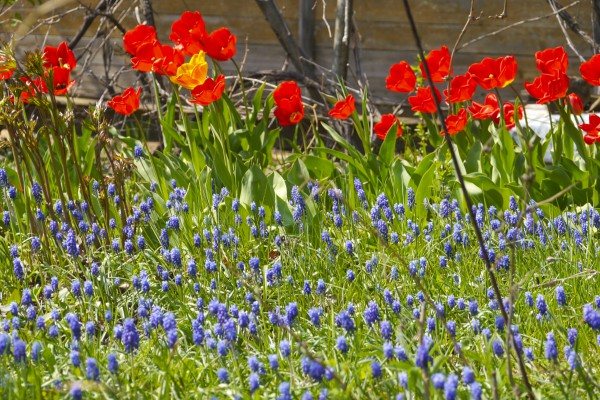

Wintering
If the autumn is long and warm, it can sometimes happen that the tulips sprout before winter. Then it is worth covering them with branches of coniferous trees, but not because the bulbs may freeze (this is an unlikely scenario), but so that the shoots do not freeze - they will develop leaves in the spring. Frost-damaged tulips look unattractive.
The shelter needs to be removed in the spring, because when the sprouts begin to grow and elongate, they will have to break through the branches that cover them. Thin and fragile shoots will break.
If the bulbs get wet during wintering, they can rot. The planting material also affects tulip spotting, gray rot, and other diseases. The most dangerous are viral diseases.
Tulip varieties with photos and names
Tulips have long been the subject of adornment and admiration in the countries of the East. Once in Europe, they immediately gained great popularity among gardeners.The variety of varieties allows you to choose the most suitable and beautiful plant. Varieties are subdivided into flowering periods, shape and color. According to the international classification, tulips are divided into 4 groups and 15 classes.
Early flowering
- Simple early flowering... This class opens up immediately after the snow melts. The varieties are undersized, grow up to half a meter. A goblet flower, 5-8 cm. The color is red or yellow. Varieties of this class are used for early planting. They are not suitable for cutting. This class includes varieties: Christmas Pearl and Purple Prince.


- Terry early varieties... Plants are not tall, flowering occurs a week later than the usual early flowering variety. Flowers in this class are double, with a flowering duration of up to two weeks. Flowers are not suitable for cutting. They look perfect in flower pots and in combination with hyacinths, crocuses and daffodils.
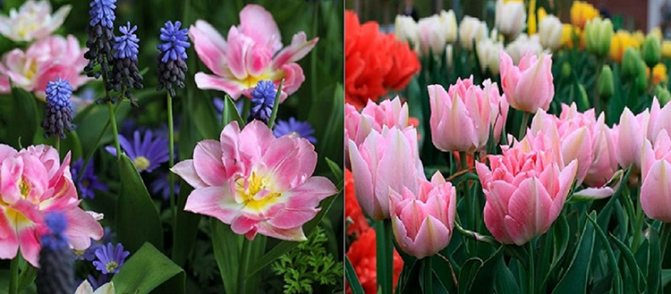

Medium flowering tulips
- Triumph tulips... The color of flowers in this group can be from white to dark purple. There are also plants with a double color. Long bloom (10-12 days), begins in early May. Plants are resistant to winds, torrential rains, and never fully open in sunny weather. Plants are tall, look good in cut and flower beds. This class includes varieties: Triumph Indian Summer and Mistress Mystic.


- Tree hybrids... Plants are tall, up to 80 cm long. Goblet flowers are pink or white in color, there are varieties with a double color. Flowering occurs early. This class has one drawback: the flower opens completely and quickly loses its decorative appearance. The advantages include disease resistance, frost resistance and good transportability. Cut flowers can stand in the water for a long time.
This group includes varieties:


Late blooming
This group is the largest and has many varieties with a variety of colors. It includes seven independent classes:
- Simple, late flowering... They are tall, vigorous plants, reaching a height of 80 cm. The goblet flowers are large, colored from white to purple. Flowering begins in mid-May.


- Liliaceae... The class has an original flower structure - large oval-shaped inflorescences have pointed petals that bend outward. Liliaceous tulips are very fond of summer residents for their resemblance to a lily. This class is represented by:
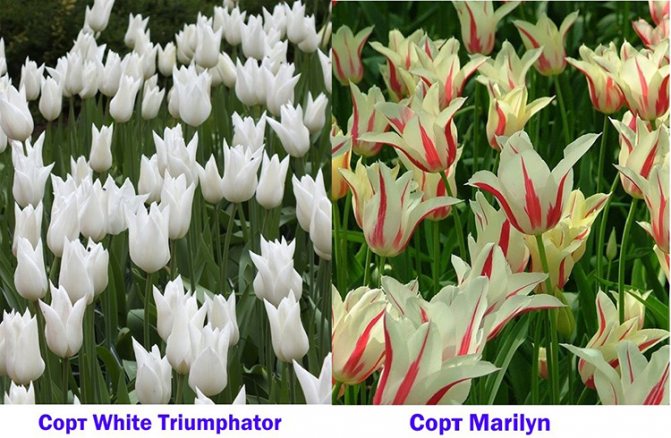

- Fringed... The difference from other specimens is the presence of a small fringe in the form of needles or crystals along the edges of the petals. The plant is tall, grows up to 75 cm. Flowering begins in May.
Breeders bred varieties in which a fringe appears on the back, as well as terry, fringed varieties. Flowers of this class look good in cut and are used for landscape decoration.


- Green-flowered... A fairly new variety, it differs from others in the presence of stripes, spots, olive-colored strokes on the outside of the petals. It is divided into types: undersized (20-30 cm) and medium-sized (35-50 cm). The stems of these plants are strong, the leaf blade is long, some varieties have a white stripe that runs along the edge of the leaf. Flowering occurs at the end of May and lasts 5-7 days. Flowers are used for making bouquets, as an addition to an alpine slide and as separate groups for decorating gardens.


- Tulips Rembrandt. Instances of this class have a multi-colored flower. The plant is tall, up to 70 cm in height, the flowers are large. Bulbs can be purchased at specialty stores, greenhouses or nurseries. The unusual color of the petals is associated with a virus that settles on the flower and paints it in stripes, strokes of different colors.


- Parrot tulip... The plant differs from other classes in its unusual flower shape. Rugged, wavy, splayed petals resemble a ruffled parrot. The flowers are large, of various colors: from snow-white to black.Flowering begins in mid-May. Flowers are used in cutting, for making bouquets, and they will also become an adornment of any personal plot.


- Late flowering double tulips... Terry, or peony, tulips begin to bloom in early June and bloom for up to 3 weeks. The flowers are large, of various colors. Compared to double early flowering tulips, the corolla of late species is much more massive and thicker. Tulips need support and planting in a place protected from gusty winds. Recently, a variety was brought out - Ice Cream. It has bright outer petals and a snow-white core. Although the variety is new, it has become very popular with flower growers for its color and unusual shape.
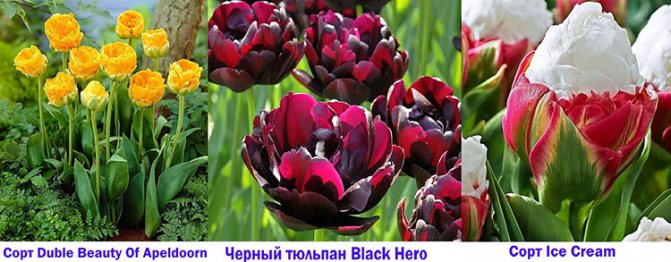

Botanical and species tulips
- Kaufman tulips - early flowering plant. The first flowers appear immediately after the snow melts. The plant is short, grows up to 25 cm, flower petals of various colors are star-shaped. The leaves are wide, some varieties have white stripes or streaks.


- Foster's tulips. Plants are medium in size - 25-30 cm. Flowers are goblet or cupped in shape, when loose, they resemble the shape of a star. The color is bright, mainly the varieties are red, in rare cases - yellow or pink.


- Greig's tulips... Plants are medium-sized, grow up to 30 cm in height. The flowers are bright and large. The color is red, orange or bicolor. Long bloom - from late April to mid-May. Because of their beautiful appearance, the plants are used to decorate garden paths and as an addition to alpine slides.


- Wild species. This class includes tulips growing in the wild. All varieties are dwarf undersized, begin to bloom in early spring. Flowers are small with varied colors.


You can visually familiarize yourself with the varieties of tulips by watching the video:
Choosing a place and preparing a bed
The successful location of the garden and the planting of tulips in the fall when and how to plant the choice will be less problematic. These flowers love sunny, sheltered spaces. There should be no puddles in the spring. The soil should be well drained - loamy or sandy loam soil with a significant amount of humus would be the best option.
Cunning
asters, watermelons, melons, zucchini, cucumbers, tomatoes are not the best predecessors for tulips.
It is worth digging the ground to a depth of 25-30 cm, carefully removing the roots of weeds, trees and shrubs. If the soil is heavy and poor, add sand and fertilizers: compost, ash, peat, mineral complexes. You cannot use cow dung - add bird droppings instead. If the PH values are increased towards oxidation, liming is required.
You need to prepare the land a month before the expected date of planting. This is necessary for the soil to “settle down”. In a loose "pillow" there is a high probability of damaging the roots that have appeared. Before direct planting, pour abundantly on the ridges - this will finally distribute the earth.
Cunning
sprinkle the formed rows with a thin layer of sand. This will serve as additional drainage and help reduce the chance of rotting.
Usually, this is where the care of tulips after planting ends in autumn. It is not necessary to cover the garden bed - this can lead to the fact that the bulb will grow ahead of time, it will winter worse and will bloom later. Exceptions are sudden cold weather. When the temperature drops sharply, use a specialized covering material. Do not use garden debris, mulch or leaves for this - this can attract rodents.
What to do with tulip babies
Tulip is a spring plant that reproduces by baby bulbs. Bulbs are planting material that carries all the properties of the variety and therefore it is important to adhere to simple rules for the timely digging and planting of children. After all, a healthy bulb that has gained the necessary supply of nutrients is the key to getting a large flower in the first warm months.
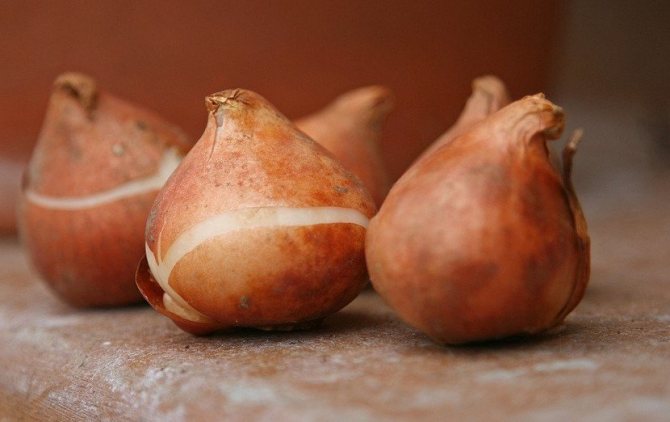

In order to maintain their varietal properties, these flowers need to be transplanted every year. Those who are engaged in the selection of these plants claim that it is the annual transplantation according to a strictly worked out scheme that allows them to get specimens with large peduncle heads in the spring, which is especially appreciated among fans of this flower family.
Did you know? In Quebec, Canada, tulips are grown for food. Moreover, both bulbs and buds and leaves of plants are used.
Dig up tulips a few weeks after the end of flowering. The main indicator for this is the leaf of the plant - it should become lethargic and turn yellow by about 2/3. Previously, it is not recommended to dig up tulips, since the bulb has not yet collected a sufficient supply of nutrients, and the children may be underdeveloped. Also, do not delay digging the plant out of the soil. If it is too late to dig up the bulbs, the babies will separate from the mother plant, and it will be quite difficult to get them out of the ground.
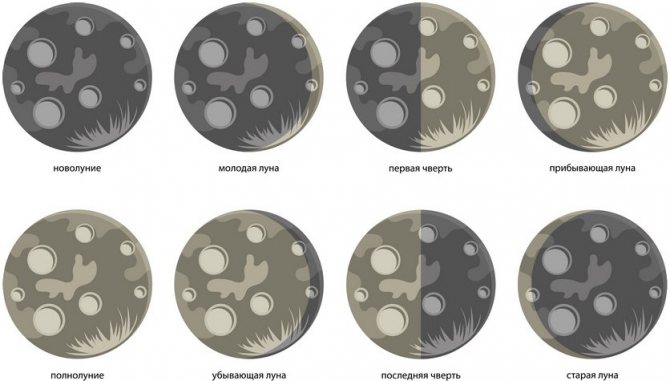

Experienced gardeners, when choosing the time to dig out the bulbs, are guided by the lunar calendar, which is due to the influence of the Moon on the rate of circulation of life juices in plants.
The small bulbs with which the plant propagates are located at the bottom of the mother's bulb. As a rule, one of them, the largest, is a kind of clone of the mother tuber. It is this baby that will give the most lush flowering and the largest flower stalk next year. The rest of the flowers will bloom somewhat smaller, but they will still retain their varietal characteristics. Experienced gardeners try to sow tulip seeds in the ground, but this is a rather time-consuming and troublesome business.
Learn how to properly plant tulips in bulb baskets.
As soon as the plant fades, the peduncle should be cut off, leaving the stem and leaves above the ground. It is through the remaining aerial part that the bulb receives all the necessary substances for the formation of high-quality planting material.
Tulip soil and planting site
For tulips, be sure to find a sunny and wind-protected place. It is desirable that the site be slightly elevated or slightly sloped. Lowlands, where water stagnates, are strongly not recommended to choose for planting tulips.
For planting tulip bulbs, loose soil, rich in humus, is suitable. You can not bring fresh manure under tulips, but only humus. Flowers prefer soil with a level of acidity close to neutral, therefore, if the soil is acidic, then liming it is necessary.
Prepare the soil for tulips no later than a month before planting. The soil must settle, otherwise, in unsettled soil, there is a possibility of damage to germinating roots.
It is very important for tulips to create a loose fertile layer. To do this, the earth must be dug to a depth of about 30 cm and fertilized. As fertilizers, you can apply fertilizers for bulbous, "Autumn" fertilizers, humus, use wood ash.
Universal composition for any soil
(in terms of 1 m2) contains:
- 5 kg of compost or humus,
- 200 gr. ash,
- 50 gr. superphosphate
- 15 grams of ammonium nitrate.
How to store tulips before planting in the fall?
Check out these articles as well
- How to properly prune gooseberries
- Raspberry variety Glen Coe
- Pear variety Just Maria
- Buckfast bee breed
When the leaves of tulips begin to turn yellow and the scales acquire a light brown color, the bulbs are dug out. The time for digging the bulbs is from late June to mid-July. After digging them up, they are sorted by size, and all sick and damaged ones are also put aside.
Important!
Dig up the bulbs as carefully as possible, using a pitchfork or similar tool that loosens the soil rather than cuts.
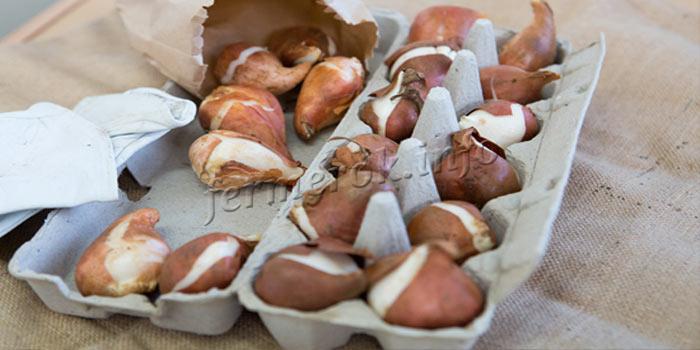

Storing tulip bulbs in an egg tray
In order for the bulbs to be in good condition at the time of planting tulips in the fall, it is important to store them correctly. Usually, the bulbs are folded neatly into a container and placed in a ventilated room, where it is dark and there are no drafts. It is very important that this room is not cold, otherwise a flower bud will not appear, but it should not be hot either, so that the bulbs do not grow. In July, about 20 degrees of heat is maintained, in August - +17 degrees, and in September not higher than +15. At the same time, they begin to ventilate the room with the bulbs so that they get used to the external conditions.
Longlines and Sandwiches: Alternative Disembarks
A creative approach will make any business interesting. This also applies to floriculture. Recently, unusual methods of planting tulips are gaining popularity. They save time, decorate the garden and attract attention. In addition, they are quite simple and everyone can master them.
Planting tulips in autumn in containers
Container planting or basket planting simplifies the tulip growing process. The essence of this method is to use baskets, containers and other containers instead of a flower bed or garden bed. They can either be dug into the ground or freely positioned in any convenient place.
The advantages of this method:
- You firmly believe that you have completely dug up the planting material. The onions themselves are minimally traumatized and, therefore, better stored.
- You create optimal conditions for plant growth. Relevant for infertile soils - it is easier to create ideal conditions in a confined space.
- Reduces the likelihood of damage to bulbs by rodents. Mice cannot get past the obstacle from below.
Anything can be used as a container: plastic bottles, boxes, baskets, pots and even bags. One condition - you need to make holes for the outflow of excess water. Use a red-hot knitting needle or other similar object for this. The holes should not be large, otherwise mice will make their way through them.
Method of planting tulip bulbs "vines"
The second way to arrange flowers in an unusual way is a tiered planting. The essence of this method is to lay the bulbs at different depths. The very first layer, starting from the bottom, is occupied by large bulbs. The higher the level, the smaller the size. In order not to make a mistake and not to plant one flower on top of another, use long thin sticks. Stick them next to the landing site, and after the flowerpot is completely filled, remove it. This combination method is also called "lasagna" - the structure resembles this dish in its layering.
It is important to take into account the color, size and shape of the petals when drawing up such a composition. Try to play on contrasts: smooth plant with terry, red with yellow. Groups of colors combined by color will look beautiful. For example, variegated with monochromatic: the color of the blotches should correspond to the mono color of the petals of the neighboring variety. A group in which tulips are selected according to the timing of flowering will look spectacular.
Cunning
you can combine different flowers. Irises, crocuses, lilies, daffodils, hyacinths and other bulbs can be added to tulips.
Video "Methods of planting tulips"
Do I need to dig up the bulbs every year


This topic creates a lot of controversy among gardeners. Most often, tulips are dug up annually, but you can leave them in the soil for 3 years. During this time, the number of bulbs will increase and in the spring the gardener will delight the gardener with an abundance of flowers. However, this has its drawbacks:
- baby bulbs can intertwine with their parents and make digging difficult;
- difficult to control the growth of tulips;
- there will be more plants in the same territory, which means that they may not have enough nutrients;
- an abundance of flowers will worsen the design of the yard if they are originally planted in the form of a pattern (due to the uneven distribution of buds).
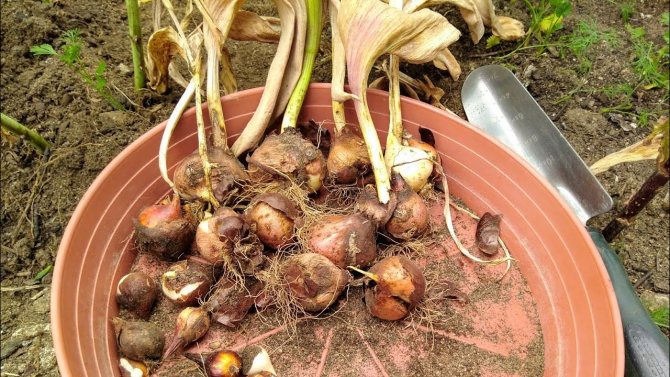

When leaving tulips for the next year, you need to analyze the soil. There will be no problems on sandy soil.If the flowers are planted in loam, it will be more difficult for them to receive nutrients. It's all about the soil under the roots, which becomes compacted over the season and ceases to be loose. The problem is solved by mixing clay soil with sand when planting the bulbs. Then you can safely leave plants of the Liliaceae family in one flower bed for up to 3 years.
Not every gardener knows how to properly plant tulips so that they bloom magnificently in spring. But you need to know the basics and follow the rules of outdoor care. For the winter, the bulbs should be covered with a layer of mulch made from sawdust, straw or bark of conifers, and the soil should be fertilized. Already in April, buds will appear on the beds, which will delight the gardener with their beauty.
How to water tulips
Now a little about watering. Do I need to water the newly planted bulbs? It all depends on the moisture content of the soil. If the soil is moist, then watering is not necessary. But in the case of landing in dry ground, you need to shed a hole or groove well.
Regularly, abundantly, tulips should be watered during the period of active growth, during budding, flowering, especially in dry years. Moisture should penetrate to the root depth (0.5 m), and not just wet the ground. After flowering, watering stops.
Remember
- Tulip bulbs are best planted in autumn.... This must be done no later than the end of October so that the plants bloom in early spring.
- Do not fertilize fresh manure when planting... Plants can get sick. Manure can be applied to the soil one year before planting bulbs.
- Thoroughly shed soil after landing... But do not allow moisture to stagnate in the holes.
- Plant only healthy bulbs... Discard spoiled specimens, and pre-soak healthy ones in a manganese solution.
- Observe planting depth... It depends on the size of the bulb. Correctly determine the depth - according to the three diameters of the bulb.
- Cover the garden with a layer of mulch for the winter.... In order for tulips to grow and bloom abundantly next year, it is better to cover the bulbs from frost.
- Feed the plants with the first leaves... During the period of intensive growth, tulips take all the nutrients from the soil. In order for the soil to retain its fertility, fertilizers need to be applied.
Now you know when to plant tulips before winter and the benefits of autumn planting. I wish you to fully enjoy the result of your labors!
Video: when to plant tulips and the main rules for planting tulips.
The soil
The bed must be dug up, weeds, their roots, stones must be carefully removed. The soil should be dug with a pitchfork to a depth of 20 cm in order to loosen it properly. The garden soil must be mixed with rotted compost. Heavy, loamy and dense soil must be mixed with coarse sand, it will become more permeable, after rain it will not accumulate water, the bulbs will not rot.
An important planting rule: you cannot plant tulips on an area where other bulbous plants were previously grown.

